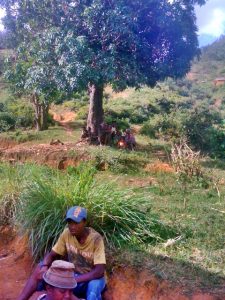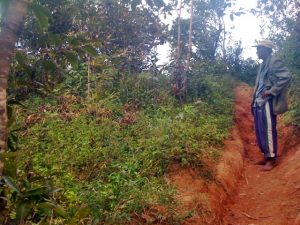Location
Anjiro, Toamasina, Madagascar — Fokontany (Neighborhood): Mahatsinjo, Ambilobe, Antanetibe
Community Description
Anjiro is a rural community located in the central highlands of Madagascar. It has a population of about 15,000 people consisting of mainly Merina and Bezanozano Malagasy tribes. However, due to its central location between the capital city and one of Madagascar’s largest port cities, all tribes can be found here.
Most of the population (95%) earns income through farming and cash crops (ginger, cassava, rice, corn, and beans). Anjiro’s “village center” is located about a half kilometer away from one of the main national roads, Route National 2 (RN2).
a half kilometer away from one of the main national roads, Route National 2 (RN2).
The community of Anjiro consists of many surrounding mountainous neighborhoods/villages, all geographically located within a 9 km radius from the commune. Many of these small communities have limited access to clean water. Community members dispose of human waste, wash clothes, and bathe from the same water source, mainly from the irrigation canals or ponds in the mountain tops that provide water to the many surrounding rice fields. Much of this water is unsanitary, as often the water source is limited to still standing water that has been sitting in the heat all day.
Community members are too poor (average income of $1.50/daily) to purchase proper water filters and/or chlorine. Small children, pregnant women, and elderly people are especially susceptible to gastrointestinal diseases brought about from consuming unsanitary water.
Project Description
This project is to build three wells and one dam in three neighboring fokontanies (neighborhoods) of Anjiro: Mahatsinjo, Antanetibe, and Ambilobe.
These three fokontanies lie on the westward perimeter of Anjiro. Their western location in relation to the main national road means that they are deeper into the bush and thus community members have a more difficult time accessing the main market and other resources which are considered luxuries (i.e. electricity).
Mahatsinjo
One 10-meter deep well will be built in a central location about 50 meters from the main cluster of homes. Currently, community members carry two buckets and walk downhill, 100 meters, to the irrigation canal to collect water, dispose of waste, and wash their clothes.
 The well’s hole will be lined with bricks when the water source is reached. A small brick house with a lock and door will be built above ground. The house’s roof will be made out of the tin.
The well’s hole will be lined with bricks when the water source is reached. A small brick house with a lock and door will be built above ground. The house’s roof will be made out of the tin.
Ambilobe
Two water projects will be executed in fokontany Ambilombe. Due to Ambilombe’s proximity to the base of a mountain and waterfall, the main cluster of homes lies at the base of the mountain and the remaining houses lie at the top of the summit.
Two water projects are required for this project as community members at the top of the waterfall dispose of human waste, which trickles down to the water source at the base (which is used by the main cluster of homes).
First, a well and brick house, similar to the one being built in Mahatsinjo, will be built at the top of the summit. The well’s hole will be about 8 m deep with similar brick lining, an above-ground brick house, and a tin roof.
The second water project in Ambilobe will be to restore/renovate an existing natural water dam. The dam has water at its base and provides water to the community members by a PVC tube.
This water source collects from below ground and allows for community members living close to the base of the mountain to access separate water from the dirty waste-filled water collected in the rice fields from the summit.
The existing dam will be enlarged by means of a 2-meter underground hole, and rocks will be placed to filter the water. Above ground, a brick house and tin roof will be built to prevent the surrounding dirt from eroding into the water source.
Antanetibe
The third well will be built in Antanetibe. This community had a water faucet built back in the 90s by a French NGO (TMD). However, the faucet does not operate on extremely hot days during the summers. Currently, community members walk downhill to the same irrigation canal, approximately 100 meters away to access water. A well will be built next to the water faucet. The well’s underground hole will span 12 m deep and will consist of the same design.
Implementation
The technology used to build the wells and dam in these water projects include hiring skilled labor to dig holes at strategic locations in each neighborhood to access a clean water source. Simple brick linings and a protective brick house above ground will be constructed to secure the area from intruders and erosion.
The community is participating in the planning and execution of the project by attending preliminary community meetings led by the President of Anjiro, M. Serge Donah. The president will be in charge of lower-level budget control for each of the neighborhoods. In addition, he will assign community representatives in each of the neighborhoods to collect, assign ownership, and contribute materials (including bricks), labor, and transport.
The communities will be responsible for the maintenance (material and financial) of the wells and dam in the long term. The construction of the dam does not damage the surrounding environment and is environmentally sustainable.
Project Impact
660 people will benefit from the project.
Peace Corps Volunteer Directing Project
Clifford Duong
Comments
This is a huge infrastructure project that accomplishes a tremendous amount with the existing resources and a modest infusion of capital. It will result in safe water for 3 neighborhoods, thereby reducing diseases from waterborne causes.
Dollar Amount of Project
$555.00
Donations Collected to Date
$555.00 + additional funds
Dollar Amount Needed
$0.00 – This project has now been fully funded through the generosity of AquaBio Environmental Technologies, of Marina del Rey, CA, USA, together with friends and family of Peace Corps Volunteer Clifford Duong, with additional funds from the Elmo Foundation for future projects in the country.
We encourage others to continue to donate using the Donate button below, and we will notify Clifford of your donation. Additional funds will be used to fund the next project by Clifford and/or those of other PCVs in the country of service.
![]() This project has been finished. To read about the conclusion of the project, CLICK HERE.
This project has been finished. To read about the conclusion of the project, CLICK HERE.